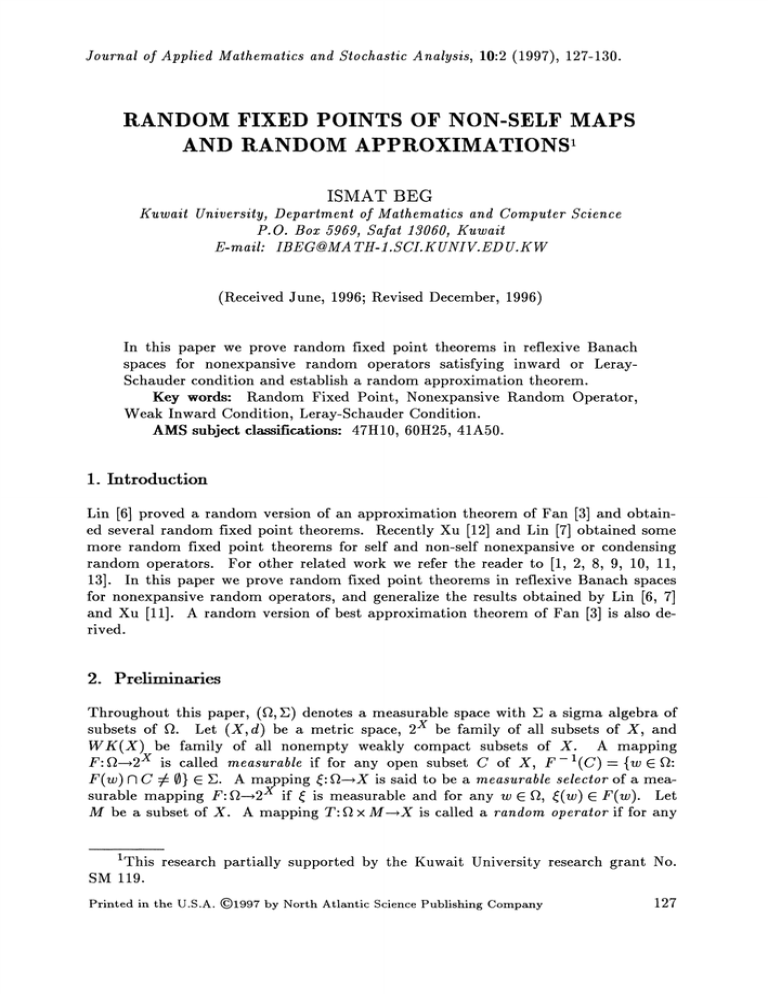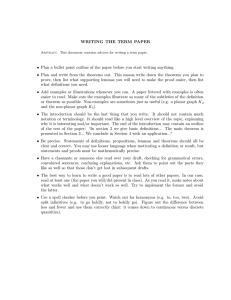FIXED AND
advertisement

Journal
of Applied Mathematics and Stochastic Analysis, 11}:2 (1997), 127-130.
RANDOM FIXED POINTS OF NON-SELF MAPS
AND RANDOM APPROXIMATIONS
ISMAT BEG
of Mathematics and Computer Science
P.O. Box 5959, Safat 13050, Kuwait
Kuwait University, Department
E-mail: IBEG@MA TH-1.SCI.KUNIV.ED U.KW
(Received June, 1996; Revised December, 1996)
In this paper
we prove random fixed point theorems in reflexive Banach
spaces for nonexpansive random operators satisfying inward or LeraySchauder condition and establish a random approximation theorem.
Key words: Random Fixed Point, Nonexpansive Random Operator,
Weak Inward Condition, Leray-Schauder Condition.
AMS subject classifications: 47H10, 60H25, 41A50.
1. Introduction
Lin [6] proved a random version of an approximation theorem of Fan [3] and obtained several random fixed point theorems. Recently Xu [12] and Lin [7] obtained some
more random fixed point theorems for self and non-self nonexpansive or condensing
random operators. For other related work we refer the reader to [1, 2, 8, 9, 10, 11,
13]. In this paper we prove random fixed point theorems in reflexive Banach spaces
for nonexpansive random operators, and generalize the results obtained by Lin [6, 7]
and Xu [11]. A random version of best approximation theorem of Fan [3] is also derived.
2. Preliminaries
Throughout this paper, (f,) denotes a measurable space with a sigma algebra of
subsets of f. Let (X,d) be a metric space, 2 x be family of all subsets of X, and
WK(X) be family of all nonempty weakly compact subsets of X. A mapping
F:f--2 x is called measurable if for any open subset C of X, F-I(C)- {w E f:
A mapping a--,X is said to be a measurable selector of a meaF(w) C C }} E
surable mapping F:ft---,2 x if is measurable and for any w ft, ((w) F(w). Let
M be a subset of X. A mapping T: f x M---X is called a random operator if for any
.
:
1This research partially supported by the
Kuwait University research grant No.
SM 119.
Printed in the U.S.A.
()1997 by North
Atlantic Science Publishing Company
127
ISMAT BEG
128
M, T(.,x) is measurable. A measurable mapping :f2---M is called a random
fixed point of a random operator T" f2 x M-X if for every w f2, (w) T(w, (w)).
A mapping T:M---,X is called k-set-Lipschitz (k > 0) if T is continuous and for
any bounded subset B of M, a(T(B))< k a(B), where c(B)- inf{e > 0:B can be
zE
covered by a finite number of sets of diameter < e}. The number a(B) is called the
(set)-measure of noncompactness of B. A k-set-Lipschitz mapping T is a k-set-contraction if k < 1. A mapping T" MX is called (set-) condensing if T is continuous
and for each bounded subset C of M with a(C) > 0, a(T(C)) < a(C). Clearly a kset-contraction mapping is condensing. A mapping T’M---X is called nonexpansive
if [[T(x)-T(y)[[ < [Ix-Y[[ for all x,yM. A random operator T:f2xMX is
continuous (condensing, nonexpansive, etc.) if for each w e f2, T(w,. )is continuous
(condensing, nonexpansive, etc.) A random operator T:f2xM--,X is said to be
weakly inward if for each w f2, T(w,x) cl IM(X for x E M, where cl denotes
closure and IM(X )-{zx:z-x+a(y-x) for some yM and a>_0}. When M
has a nonempty interior, a random operator T: f2 x M---X is said to satisfy the LeraySchauder condition if for each w f2, there exists an element z int(M) (depending
on w)such that
T(w, y)- z 5 a(y- z)
(i)
for all y in the boundary of M and a > 1.
A mapping T: M--,X is said to be demiclosed at y X if, for any sequence {Xn}
in M, the conditions xn---x M weakly and T(Xn)--*y strongly imply T(x) y.
Theorem 2.1: [Xu, 12]. Let C be a nonempty closed convex subset of a separable
Banach space X,T:fC---,X be a condensing random operator that is either
(i) weakly inward or (ii) satisfies the Leray-Schauder condition. Suppose, for each
w f, T(w, C) is bounded. Then T has a random fixed point.
lmark 2.2: Theorem 2.1 remains true if C is separable instead of X being separable.
3. The Main Results
Theorem 3.1: Let C be a nonempty closed bounded convex separable subset of a reflexive Banach space X and let T: f2 x C---X be a weakly inward nonexpansive random operator. Suppose for each w f2, I-T(w,.) is demiclosed at zero. Then T
has a random fixed point.
Proof: Take an element v C and a sequence {kn} of real numbers such that
0 < k n < 1 and kn---*O as n--- oc. For each n, define a mapping fn:X C----X by
f n(W, x) knv + (1 kn)T(w x). Then, f n is a weakly inward (1 kn)-set-contraction random operator. Hence by Theorem 2.1 (i) and Remark 2.2, there is a random
fixed point
of fn" Since X is a reflexive Banach space, w-cl{i(w)} is weakly
compact.
Let C be a weakly closed and bounded subset of X containing w- cl{i(w)}. For
each n, define Fn:f2--*WK(C by Fn(w --w-cl{i(w):i >_ n}. Let F:f2--WK(C)
n
be a mapping defined by
F(w)n=l
t;’n(w ). Then,
,
.
as in Itoh
[5, proof of Theorem
This is the desired ran2.5], F is w-measurable and has a measurable selector
dom fixed point of T. Indeed, fix any w E
then some subsequence {m(W)} of
Random Fixed Points
of Non-Self Maps
and Random Approximations
129
{n(W)} converges weakly to (w). On the other hand, we have m(W)T(w,(m(W)) kmlv- T(w,(m(W))}. Thus {(m(W) T(w, (re(w))] converges to 0.
Since I- T(w,. )is demiclosed at zero, it follows that ((w)= T(w, (w)).
If T: f x CC then we have the following:
Theorem 3.2: Let C be a nonempty closed bounded convex separable subset of a
reflexive Banach space and let T:fx C--.C be a nonexpansive random operator.
Suppose for each w Eft, I-T(w,.) is demiclosed at zero. Then T has a random
fixed point.
Theorem 3.3: Let C be a nonempty closed bounded convex separable subset of a
reflexive Banach space X and has a nonempty interior. Let T: f x C--X be a nonexpassive random operator that satisfies the Leray-Schauder condition. Suppose for
each w
I- T(w, .) is demiclosed at zero. Then T has a random fixed point.
Proof: Let z z(w) int(C) satisfy inequality (1). Take a sequence {ks} of real
numbers such that 0 < k n < 1 and knO as n. For each n, define a mapping fn:
n x CX by fn(w, X) knz + (1 kn)T(w x). Then fn is a random (1 kn)-Set-contraction operator that satisfies the Leray-Schauder condition. Then, by Theorem 2.1
Define a sequence of mappings
(ii) and Remark 2.2, fn has a random fixed point
a
and
the
as
in
proof of Theorem a.1. Then
mapping E:WK(C)
En:WK(C
F is measurable and has a measurable selector
This is the desired random fixed
point of T.
The following is a special case of Theorem 3.2, which extends the results of Lin
Theorem
[6,
3] and Lin [7, Corollary 3.2].
Theorem 3.4: Let C be a nonempty closed bounded convex separable subset of a
Hilber space X and let T:xCX be a nonexpansive random operator. Then
here exists a measurable map :C such lhat
,
.
for each
w
.
Proof: Let P be the proximity map on
into C such that for each y X we have
I[ P(Y)- Y I
n"
C, that is, P is a continuous map from X
d(y, C).
Since both P and T are nonexpansive, the random operator P o T:f x C--,C is
also nonexpansive. By Theorem 3.2 there ekists a random fixed point of P o T, that
is, there exists a measurable map :f--C such that P o T(w,(w))= (w), for each
w f. Therefore,
11 (w)- T(w, F,(w)) l[
11 P o T(w, ,(w)) T(w, f,(w)) [[
:d(T(w,((w)),C),
for each w E f.
Remark 3.5:
Immediate corollaries to Theorems 3.1 are Lin [6, Theorem 6’(ii)] and Lin [7,
(i)
Corollary 4.2 (iii)].
Theorem 3.2 generalizes Lin [6, Lemma 1] and Xu [12, Theorem 1].
(ii)
(iii) The fixed point property of C and strict convexity of X in Xu [12, Theorem
1] are not needed.
ISMAT BEG
130
(iv)
Theorem 3.3 extends Xu
[12, Theorem 4].
References
[1]
Beg, I. and Shahzad, N., Random fixed points of random multivalued operators
on Polish spaces, Nonlinear Analysis 20
[2]
[4]
[6]
[7]
[8]
[9]
[10]
[11]
[12]
[13]
(1993), 835-847.
Beg, I. and Shahzad, N., Random fixed points of weakly inward operators in
conical shells, J. Appl. Math. Stoch. Anal. 8 (1995), 261-264.
Fan, Ky, Extensions of two fixed point theorems of F.E. Browder, Math. Z. 112
(1969), 234-240.
Himmelbeg, C.J., Measurable relations, Fund. Math. 87 (1975), 53-72.
Itoh, S., Random fixed point theorems with an application to random differential equations in Banach spaces, J. Math. Anal. Appl. 67 (1979), 261-273.
Lin, T.C., Random approximations and random fixed point theorems for nonself maps, Proc. Amer. Math. Soc. 103 (1988), 1129-1135.
Lin, T.C., Random approximations and random fixed point theorems for
continuous 1-set contractive random maps, Proc. Amer. Math. Soc. 123 (1995),
1167-1176.
Papageorgiou, N.S., Random fixed point theorems for multifunctions, Math.
Japonica 29 (1984), 93-106.
Sehgal, V.M. and Waters, C., Some random fixed point theorems, Contemporary Math. 21 (1983), 215-218.
Tan, K.K. and Yuan, X.Z., Some random fixed point theorems, Fixed Point
Theory and Applications (ed. by K.K. Tan), World Scientific, Singapore (1992),
334-345.
Wagner, D.H., Survey of measurable selection theorems, SIAM J. Contr.
Optim. 15 (1977), 859-903.
Xu, H.K., Some random fixed point theorems for condensing and nonexpansive
operators, Proc. Amer. Math. Soc. 110 (1990), 395-400.
Yuan, X.Z. and Roy, J.M., Some deterministic and random variational
inequalities and their applications, J. Appl. Math. and Stoch. Anal. 8 (1995),
381-395.




